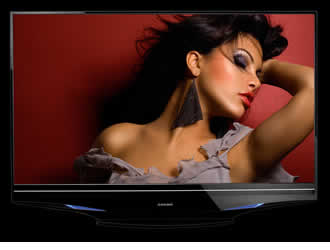Mitsubishi L65-A90 Laservue Laser TV
Mitsubishi Updated: 2009-04-15 RSS
A Revolution, Brought To You In Color
All video displays derive their colors from the three video "primary" colors: red, green and blue. By combining these in different amounts, engineers can theoretically reproduce every other visible hue. But there are limitations. Today's plasmas and yesterday's cathoderay tube televisions, for example, make red, green and blue phosphors glow at just the right brightness to create specific colors, but even the best of these TVs can reproduce no more than about half the color spectrum visible by the human eye. Put simply, the red, green and blue just aren't red, green or blue enough to do justice to real life. Likewise, the red, green and blue filters used to create color from "white" light in most LCD flat-panels are even more limited than a plasma's phosphors in reproducing the full range of color. Enter laser—an acronym for Light Amplification by Stimulated Emission of Radiation. That's a pretty technical term, but practically speaking, laser light differs from ordinary light in some remarkable and beneficial ways. Unlike broad-spectrum white light that illuminates our world, laser light can be generated to reproduce only a very narrow bandwidth of the visible spectrum — far more narrow than you'd get from using phosphors or by filtering white light to produce the red, green and blue primaries. The result, shown in the Spectrum Comparison below, is much purer, brighter, primary colors from which to generate all the remaining colors.
The Magic Within
Putting the laser to work in an TV was no small engineering feat. Mitsubishi harnessed lasers for each primary color—red, green and blue —eliminating the need for filters and their inherent compromises. The output of the lasers remains consistent and true for the life of the product. Unlike displays that use traditional illumination sources, the uniform and focused nature of laser light means no complex path of optical components is required to gather and align the light output. Instead, fiber optic cables channel the laser outputs to the imager, resulting in a compact, simpler light engine that can be located separately from the laser source. This, combined with the use of advanced optics, results in an amazingly thin depth of about 10 inches for a 65-inch diagonal screen size. In fact, LaserVue's cabinet is so shallow it can be wall-mounted using an optional mounting kit. And its sleek, thin-bezel design allows its large image to practically float in space, achieving an aesthetic that cannot be matched by flat-panel TVs.
True Green
Thanks to the concentrated intensity of its laser beams, LaserVue's picture rivals the brightness of flat panel TV. Yet, it consumes only about one-third the power of similarly sized LCD televisions, and as little as one-quarter the energy of like-sized plasmas. This makes LaserVue the most energy efficient large screen TV ever made. The Operating Energy Consumption chart shows how the 65-inch LaserVue model L65-A90 compares with current LCD and plasma flat-panel TV models. While the flat-panels consume anywhere from 525 watts to as much as 700 watts of power, the LaserVue is rated at just 135 watts. At an average of 8 viewing hours a day for the typical household, the annual operating cost for LaserVue comes to a meager $45. Besides saving you money, LaserVue's energy efficiency contributes to the conservation of natural resources and the reduction of greenhouse gases that cause global warming. With 112 million TV households in the U.S. alone, imagine the environmental impact if each owned a LaserVue TV?
Ready for 3D?
Besides delivering the most advanced display technology, Mitsubishi futureproofed LaserVue with all the features you'd expect in a state-of-the-art TV, and some you wouldn't. The L65-A90's fast-switching lasers and "Smooth 120" 120 Hz refresh technology establishes a viewing platform that's tailor-made for 3D video*. And while more 3D programming continues to emerge from Hollywood, Mitsubishi's recently announced relationship with NVIDIA® Corporation and Aspen Media Products™, LLC will soon provide the first turnkey 3D solution for home television viewers. The True Dimension 3D system will turn any Windows Vista® PC equipped with one of NVIDIA's sophisticated graphics cards into a true 3D image source. Gamers will be able to don 3D glasses and enjoy an engaging visual experience unlike any other. Unrivaled color and picture performance. Sleek, compact design. Earth-friendly energy efficiency. Futureready features. That's LaserVue. Experience it at a retailer near you, and escape the bounds of flat-panel television.
* Height: 39.8"
* Width: 57.7"
* Depth w/o foot: 10.6"
* Weight: 136.4 lbs
* Exclusive LaserVue™ Light Engine
* Twice the Color*
* Ultra-Energy Efficient
* UltraThin Frame™
* Wall-Mountable
* 1080p Display
* 3D Ready
* Deep Color
* Easy Connect™
* x.v.Color™
* PerfectColor™
* 4 HDMI™ w/CEC Inputs
* Wired IR Input
User Guide
Specifications Sheet
Related Manuals
Element Electronics ELCP0321 LCD HDTV
Element Electronics ELCHS321 LCD HDTV
Element Electronics ELCHS371 LCD HDTV
Element Electronics ELCHS372 LCD HDTV
Element Electronics ELCP0371 LCD HDTV
Element Electronics ELCHS261 LCD HDTV
Element Electronics ELCP0191 LCD HDTV
Element Electronics FLW-1920B LCD HDTV
Element Electronics FLW-1921B LCD HDTV
Westinghouse VK-42F240S LCD HDTV
Westinghouse TX-42F450S LCD HDTV
Westinghouse TX-52F480S LCD HDTV